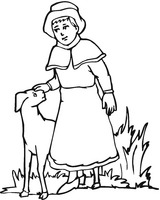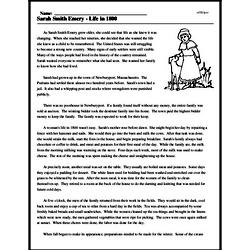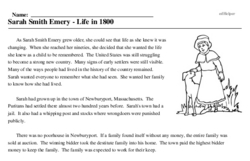Sarah Smith Emery - Life in 1800
As Sarah Smith Emery grew older, she could see that life as she knew it was changing. When she reached her nineties, she decided that she wanted the life she knew as a child to be remembered. The United States was still struggling to become a strong new country. Many signs of early settlers were still visible. Many of the ways people had lived in the history of the country remained. Sarah wanted everyone to remember what she had seen. She wanted her family to know how she had lived.
Sarah had grown up in the town of Newburyport, Massachusetts. The Puritans had settled there almost two hundred years before. Sarah's town had a jail. It also had a whipping post and stocks where wrongdoers were punished publicly.
There was no poorhouse in Newburyport. If a family found itself without any money, the entire family was sold at auction. The winning bidder took the destitute family into his home. The town paid the highest bidder money to keep the family. The family was expected to work for their keep.
A woman's life in 1800 wasn't easy. Sarah's mother rose before dawn. She might begin her day by repairing a fence with her hammer and nails. She would then go into the barn and milk the cows. After that task was done, she would strain the milk, start the fires in the house, and begin preparing breakfast. Sarah's family always had chocolate or coffee to drink, and meat and potatoes for their first meal of the day. While the family ate, the milk from the morning milking was warming on the stove. Four days each week, most of the milk was used to make cheese. The rest of the morning was spent making the cheese and straightening up the house.
At precisely noon, another meal was set on the table. They usually ate boiled meat and potatoes. Some days they enjoyed a pudding for dessert. The white linen used for bedding had been washed and stretched out over the grass to be whitened by the sun. After the noon meal, it was time for the women of the family to clean themselves up. They retired to a room at the back of the house to do the darning and knitting that was needed for future cold days.




